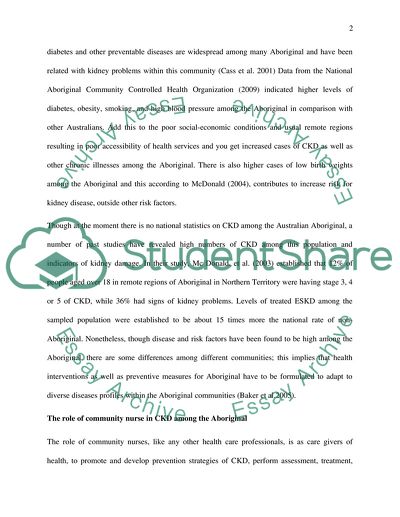Cite this document
(“Prevalence of CKD among the Aboriginal and the Risk Factors Essay”, n.d.)
Prevalence of CKD among the Aboriginal and the Risk Factors Essay. Retrieved from https://studentshare.org/nursing/1579766-topic-chronic-renal-disease-is-a-complex-problem-for-australian-aboriginal-peoples-related-to-inequitable-access-to-health-care-equity-and-access-is-an-important-principle-of-primary-health-care-examine-community-nurse-chn-roles-and-skills-required
Prevalence of CKD among the Aboriginal and the Risk Factors Essay. Retrieved from https://studentshare.org/nursing/1579766-topic-chronic-renal-disease-is-a-complex-problem-for-australian-aboriginal-peoples-related-to-inequitable-access-to-health-care-equity-and-access-is-an-important-principle-of-primary-health-care-examine-community-nurse-chn-roles-and-skills-required
(Prevalence of CKD Among the Aboriginal and the Risk Factors Essay)
Prevalence of CKD Among the Aboriginal and the Risk Factors Essay. https://studentshare.org/nursing/1579766-topic-chronic-renal-disease-is-a-complex-problem-for-australian-aboriginal-peoples-related-to-inequitable-access-to-health-care-equity-and-access-is-an-important-principle-of-primary-health-care-examine-community-nurse-chn-roles-and-skills-required.
Prevalence of CKD Among the Aboriginal and the Risk Factors Essay. https://studentshare.org/nursing/1579766-topic-chronic-renal-disease-is-a-complex-problem-for-australian-aboriginal-peoples-related-to-inequitable-access-to-health-care-equity-and-access-is-an-important-principle-of-primary-health-care-examine-community-nurse-chn-roles-and-skills-required.
“Prevalence of CKD Among the Aboriginal and the Risk Factors Essay”, n.d. https://studentshare.org/nursing/1579766-topic-chronic-renal-disease-is-a-complex-problem-for-australian-aboriginal-peoples-related-to-inequitable-access-to-health-care-equity-and-access-is-an-important-principle-of-primary-health-care-examine-community-nurse-chn-roles-and-skills-required.


